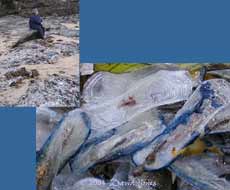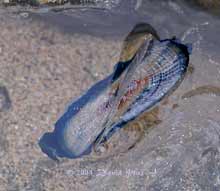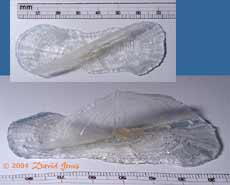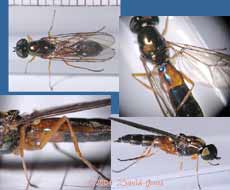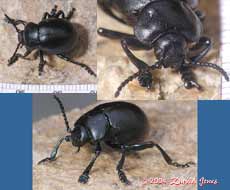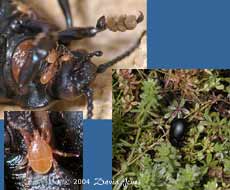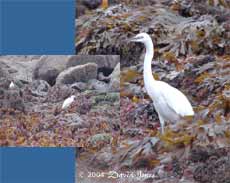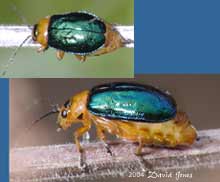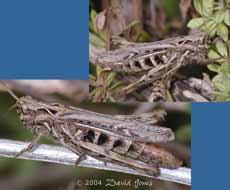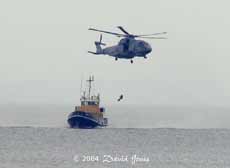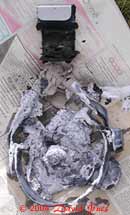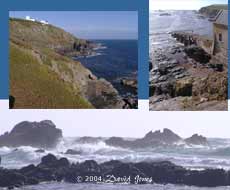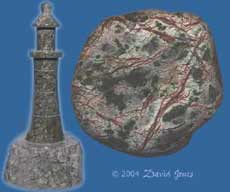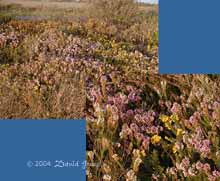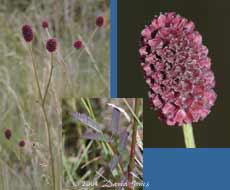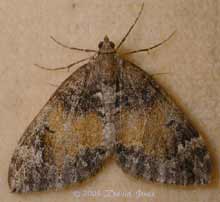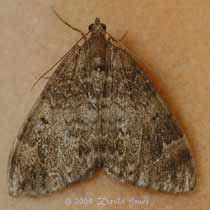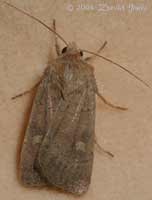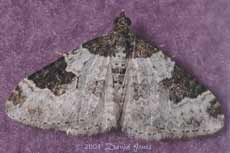Go to last entry on this page....................Go to previous entry25 September - We set out for Cornwall at around 7am, and after a couple of stops on the way we were having a cup of tea in our caravan at around 2pm, having sorted out everything. We had passed through thick mist from Bodmin Moor onwards, but by the time we reached the Lizard it had lifted, although the rest of the day remained largely cloudy. In the afternoon we took a trip down to Poldhu Cove on the Western side of the Lizard - a sandy cove that we used to visit frequently when our sons were young as it is more exposed to the westerly Atlantic swells than the more sheltered coves we frequent these days.
As we approached the water's edge there they were, thousands upon thousands of By-the-wind Sailors (Velella velella). They were not actually coming in on that tide, but their position, low down the beach and well below the high tide line, suggested that they had come ashore as the early morning tide had receded.
I searched right across the width of the cove but was unable to see any that were still alive. In most cases, all that was left was the colourless, transluscent float and sail, although some still had bright blue traces of the polyps that once hung down below it. Still, it was an amazing sight, and my first ever glimpse of these creatures.
Having said that, the word creature doesn't really do it justice as it is a well organised floating colony of individual polyps, the ones around the edge acting as tentacle to capture food that is passed to a central polyp that digests it. There is a third type of polyp that act as reproductive organs for the colony. I collected a few of the floats, and these pictures were taken back at the caravan. I understand that Velella occurs in two variants, ones where the sail is oriented NE to SW along the long axis (left handed), and those where it's orientation is NW to SE (right handed). All the specimens I picked up were right handed. It seems that the sail's angle will normally cause Velella to travel at 45 degrees to the true wind direction so that right and left forms will travel in different directions. I also kept a look out for other species that sometimes accompany Velella but without success. 26 September - Much of today was spent relaxing at Lizard point (most southery point on the British mainland), watching the ships go by. I spent a short time down in the cove on the west side of the point and found just small numbers of Velella there. Again, their position on the shore suggested that they had not long been washed ashore. I couldn't see any in the water, although the sea was choppy. 27 September - Over the last couple of days the camera has had little use. There have been some butterflies about in the filed around the caravan, but I haven't been able to get close to them. I have yet to see any moths in the men's washroom (unusual!) but in the evening I did encounter a bat there, which left before I had a chance to see it properly. During our summer visit I found the floor littered with moth wings one morning. I can only guess that a bat had visited during the night, after the moths had been attracted into the building by the bright lights the previous evening.
Here are some images of a visitor to our caravan awning today. It had a really striking metallic bronze sheen which the photographs do not really show. At first I thought it was a hoverfly but my insect guide suggests that it is a soldier-fly, possibly Sargus bipunctatus (or similar).
28 September - Today was split between Porthallow Cove (where we usually spend most of our time) and the Lizard Point again.
This time, a walk across the pebbles of Porthallow was rewarded by the discovery of a couple of these magnificent beetles with feet that seemed to be a couple of sizes too big. My insect guide suggests that they are Bloody-nosed Beetles (Timarcha tenebricosa), named after their habit of exuding a drop of red blood from their mouths when disturbed, although this didn't happen, even when I handled them.
The left hand images show how one of the beetles was playing host to four very agile mites(?). The top image also shows the hairy pads that are present under each foot.
29 September - Another day spent mainly down in Porthallow. The sea was flat calm and I managed to get out on my kayak for the first (and only) time this week and thoroughly myself. I paddled round to the next bay (Porthkerris) and had a Dogfish swim up next to the kayak when I was next to some rocks that are offshore there (no camera!).
It was very sensitive to any movement and I had to wade out behind rocks to get these shots, and take care not to get sea water on the camera. The right hand image is rather over-exposed, but I didn't risk fiddling with camera settings in the rather wet conditions!
Afterwards I walked over to the spot where I saw the beetles yesterday. They were still there, on the bedstraw plants ( don't know the species), and this time another beetle on the same plant caught my eye. This little one was about 1cm long with an metallic green elytra that looks far too small for it.
Since my return it has been identified for me as Sermylassa halensis (one of the leaf beetles), a fairly common beetle. The females' abdomens look like this when they are full of eggs. Thanks to Chris Sullivan for the ID.
Also on the plant was this Common Field Grasshopper (?)
Out at sea, in Falmouth Bay, this helicopter training went on for much of the afternoon. The Merlin helicopter followed the training vessel (Meon) as it travelled up-wind, depositing a crewman onto its rear end, and then lifting him off again. At least once he landed flat on his back!
30 September - A day to recover after a night to forget!
The picture shows the offending object, mostly melted and covered with powder from the extinguisher. It had been hanging from the bracket, but had melted and fallen down from it. There was a small amount of cosmetic damage done to the cupboard the fan had been hanging from, and the carpet it fell onto - a repair job that will keep me occupied on a cold winter's day.
No two days ever seem the same here, although this week we didn't see the sea at its most aggressive. It's always a treat to be here during a south-westerly storm, preferably when the tide is low, exposing the rocks that extend out about half a mile from the point. The top-right image shows the old lifeboat station, exposed to such gales, and which was in use until 1962 when a new station was opened on the sheltered eastern side of the headland. One aspect of the whole of the Lizard peninsular that I enjoy is the great range of rocks to be found here. Every walk on a beach turns up with interesting pebbles with varieties of patterns and colours. Some of the most spectacular are of Serpentine, such as the pebble shown on the right of this image. On of the main souvenirs of a visit to the Lizard is a piece of Serpentine that has been turned by one of the local craftsmen into a lighthouse. This one, bought many years ago, measures just 4 inches - they can be a couple of feet tall, with a light on top.
On our way back to the caravan we stopped by the side of the road to take a look at the Cornish Heath that is widespread on the heathland of the Lizard. It seems that it only grows on serpentine, and is found virtually nowhere else in Britain. The gorse that is also present creates a striking yellow contrast to the more subdued pinks of the heath.
Standing out from and area of grass was this solitary example of a Great Burnet, another plant that favours serpentine rocks, although I couldn't see any others in the area around me.
1 October - The weather this week hasn't been brilliant, although we have been able to get out every day and there has been very little rain. I suppose the dull, but not cold conditions have discouraged the moths. This morning was the only time I have found any attracted by the lighting in the men's washrooms - just the four individuals shown below (all photographed in the caravan before being released again - Sheila was very patient!).
All were small, and this first one is a common marbled carpet, a species that I photographed at home on 19 September.
This second one had very similar markings but there was no trace of the orange patches seen in the first moth.
This was a very drab moth. The nearest match I can find in my moth guides is a Cabbage Moth, although the illustration shown suggests bolder markings. Subsequently it was identified by Janice Green ( visit her excellent wildlife website) and Tim Norriss as a square-spot rustic (Xestia xanthographa)
I'm pretty certain that this last one is a Garden Carpet moth (Xanthorhoe fluctuata), although my guide says that it is most common in suburbs, and less so in the countryside!
There have been some butterflies about the campsite this week but it was impossible to get close. As well as the usual Large Whites, I think there were Gatekeepers and another brown coloured type. 6 October - Catching up time! We left Cornwall on the 2nd and stayed for two nights at a caravan site in the middle of Exeter racecourse, on top of a hill. On Sunday night the site experienced what was described as its worst gale for many years, with heavy rain and high winds that continued all night - another sleepless night. Monday was bright, sunny and perfect for the drive home, on the best day, weatherwise, all week - typical! |
|
